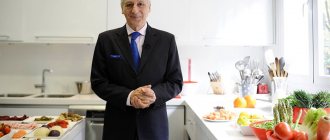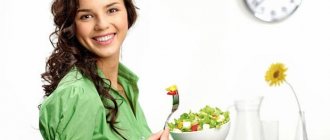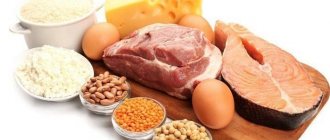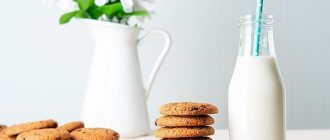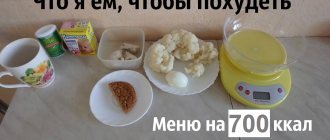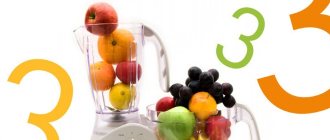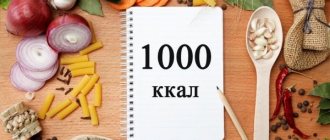The essence of the diet
The basic principles of the diet are separate meals with alternating protein and carbohydrate days. All meals are divided according to the principle: 1 day - one food group or product. Thus, the 6 petals diet consists of six days:
- Rybny.
- Vegetable.
- Chicken.
- Cereal.
- Cottage cheese.
- Fruity.
The menu for each day is based on the specified product group. You cannot mix food. During each day, the body receives the substances necessary for life: vitamins, minerals, omega fatty acids, proteins, carbohydrates, fiber, etc.
Despite the fact that each day replenishes the body with useful substances, you need to remember that many of them must be replenished daily, and not once a week. What does it mean. Every day the body needs a certain amount, for example, a vitamin. But you can’t “eat up” on fruits rich in them for a week.
All vitamins entering the body are consumed on the day of admission, and the excess is excreted from the body. The next day you need to eat fruits/vegetables again. Therefore, during the diet, make sure to take a vitamin-mineral complex . The same is true with proteins, carbohydrates and fats.
Considering the need to daily replenish important substances for the body, follow the recommended diet periods. Remember that this is a temporary measure and not a permanent nutrition system. The 6 petals diet, although attractive with its variety, remains a form of mono-diet; after finishing, stick to a balanced diet.
Rules
The main rule of the diet is to follow a sequence of days. You cannot swap them or mix products with each other. According to the developed system, it is the alternation of carbohydrate and protein days that helps accelerate the process of burning accumulated fat.
To make nutrition interesting, and the 6-day diet not so burdensome, the author suggests making a flower with six petals yourself. You can simply find it, print it and cut it out, but it’s best to draw it yourself.
On each petal you need to put the number of the day and write the name, for example, “Day 1 – fish”. Each day can be colored with a different color that you associate with the product. Upon completion of each stage, you will tear off the desired petal.
The diet involves only one cycle of 6 days, then exiting it and taking a break for at least 2-3 months. But you can increase the duration to 4 cycles/circles. So, after finishing the fruit day, you start again with the fish day.
You cannot diet for more than four repetitions. This can significantly harm your health. And in the case of a long-term diet, the break should no longer be 2-3 months, but at least 6.
In addition to those mentioned, there are other rules that must be followed to obtain maximum effect:
- All food must be chewed thoroughly.
- It is important to drink a lot of fluid, but not during meals, but in between.
- Meals should be not only separate, but also fractional. It is best to divide the entire amount of food into small portions and eat them throughout the day.
- Last meal 2-3 hours before bedtime.
- At the end of the diet, you need to get out of it correctly, and then stick to a balanced diet.
- Throughout the entire cycle (or several), take mineral and vitamin complexes and monitor your well-being. If you feel unwell or have problems with bowel movements, you need to complete the diet.
- Combine your nutritional system with physical activity. This will increase the number of kilograms you lose and also make your body fit and slender. But it is better to slow down the pace of training and make it medium intensity. Following a mono-diet can lead to loss of strength.
- It is better to boil, stew, bake or steam food. Grilling and eating raw is allowed. Avoid frying and stewing using oil or fat.
Diet menu for the week
This method of losing weight consists of mono-days, that is, at each stage it is proposed to eat only foods rich in proteins or carbohydrates. Seafood, chicken, fruits, vegetables, cottage cheese and cereals are allowed for consumption. During the day you can eat one thing, but prepared in different ways with the addition of salt and seasonings or herbs. It is important to follow the specified sequence of days.
Fish day
The beginning of the petal diet is the protein stage. Fish and seafood are rich in omega-3 polyunsaturated fatty acids, which are not deposited in problem areas, but at the same time provide the body with the necessary energy. They also help break down existing “reserves” of fat.
For the whole day you need to eat no more than half a kilogram of fish. You can eat any variety, both fatty and low-fat. Fish should be boiled, stewed with spices, but without oil, steamed, baked in the oven, and prepared in soup with herbs.
Vegetable day
The second stage is carbohydrate, designed to improve metabolism and remove waste and toxins from the body. In addition, unlike fast and harmful carbohydrates in sweets and baked goods, in vegetables they are complex and take a long time to be absorbed by the body. He needs to spend energy processing them.
During the day, vegetables can simply be eaten raw or grated, cooked in a stew without oil with spices, stewed or steamed.
Chicken day
The third stage is again proteins. Chicken meat is rich in “building” elements for muscles. However, it is digested quite quickly, so you can soon feel hungry. In order not to break down, you should drink more still water. It fills space in the stomach and protects against overeating.
The menu of the third day of the petal diet can be varied with chicken soup with herbs (parsley, basil, celery, dill), fillet baked in foil in the oven. Meat may be grilled. Also, in addition to tea, coffee and herbal infusions, you can drink broth.
Cereal day
The fourth stage, carbohydrate, will help replenish energy reserves. The menu will consist of different types of porridges: buckwheat, rice (it is better to take brown rice), oatmeal, barley, wheat. You can cook it only in water; if desired, add a salad of greens or season with spices. You are also allowed to snack on slices of whole grain bread, but you should not overuse them.
Curd day
The fifth stage is protein. This day is the most difficult, because you will only have to eat cottage cheese with a fat content of no more than 9%, low-fat and unsweetened yogurt, and kefir. All this can be alternated in any order in the daily menu, the main thing is that the total amount does not exceed half a kilogram.
Fruit day
The sixth stage, carbohydrate, is the sweetest and most delicious. After the ascetic menu of the previous days of the petal diet, taste buds may become aggravated. You can eat all fruits, except bananas, grapes, mangoes, and dried fruits. You can diversify the menu with fruit plates, pureed apples, pears baked in their own juice with cinnamon and ginger, nutmeg, and you can also make salads by sprinkling them with lemon juice.
The last day of the week is to consolidate the results and transition to a normal diet. At this stage, the diet can be composed of the most favorite foods that were present during the petal diet.
About the 6 petals diet, watch this video:
results
The author of this diet does not promise big weight loss right away. The results of the petal diet are quite modest, but very real - from 3 to 5 kg in 6 days. Every day you will lose from 0.5 to 0.8 kg.
If you do not just one cycle, but 4, in one approach, then the results will also be 4 times greater. In 24 days on a diet you can lose up to 20 kg. True, from the second week the rate of weight loss may decrease. In addition, a lot depends on the initial weight.
Expert advice
The quality of the products affects the result and course of the petal diet, so you should follow the following rules:
- Everything should be fresh, clean and well processed.
- For the fourth stage, whole grains are needed so that beneficial substances and vitamins are not lost during cleaning.
- Starchy vegetables should be excluded because they act like sugar.
- Chicken meat should be cooked and eaten without skin.
However, experts urge you not to go on short-term diets, but to stick to a healthy diet and move more. To effectively lose weight, you need a balanced diet, a variety of foods, and a loss of no more than 4 kilograms per month.
We recommend reading about Michel Montignac's diet. You will learn about the principles of losing weight, the pros and cons of the method, menus, healthy recipes, and results. And here is more information about the cucumber diet.
The petal diet will help you lose some excess weight, but only if used wisely and combined with an active lifestyle. Healthy eating rules are much more effective than short-term diets that promise significant weight loss.
Advantages and disadvantages
The benefits of a flower diet are:
- varied menu thanks to the daily change of the main product;
- real, achievable and stable result;
- easy entry and exit from the diet;
- short period (you can limit yourself to one circle every 6 days);
- can be repeated after 2-3 months (for example, with a protein or drinking diet, the break should be at least 6 months).
Compared to many diets, six petals has no significant disadvantages. This system eliminates fasting and strict calorie restrictions, although there is a standard for the volume of food. One of the disadvantages is that the diet is unbalanced, so you cannot use the diet as a permanent diet, only temporarily.
Contraindications
It is best to resort to a flower diet with the permission of a doctor and in good health. If it is not possible to consult a specialist, then look at the contraindications and make sure that you do not belong to one/several of the groups.
The Six Petals Diet is contraindicated:
- pregnant and breastfeeding women;
- children and teenagers;
- people with diseases of the gastrointestinal tract (gastritis, ulcers);
- for diseases of the pancreas, liver and kidneys;
- for diseases of the cardiovascular system;
- people with diabetes.
Who is the diet suitable for?
The original weight loss scheme successfully combines two factors: limiting calorie intake and psychological motivation. Therefore, the petal diet can be safely recommended to everyone who:
- cannot find internal motivational opportunities and willpower for food restrictions;
- wants to lose weight quickly without extreme physical activity;
- does not tolerate hunger and low-calorie fasting days;
- loves to plan her meals and not “bother” about preparing complex dietary dishes.
Important! On the six petals diet, you can get rid of 500-800 g of excess weight every day. The overall decrease in body weight at the end of the diet cycle is at least 3 kg.
You can lose much more on a diet, but to do this you will have to go through several “chamomile” cycles. There are cases where men and women managed to lose 15-18 kg.
Do's and Don'ts
During the diet, foods that correspond to a specific day are allowed. These are different types of fish, all vegetables and fruits, chicken, low-fat cottage cheese, kefir and yogurt, as well as any cereals. Additionally, you can use greens any day: add them to dishes or make cocktails from them.
From liquid, throughout the diet, you need to drink regular purified or mineral (not carbonated) water, as well as green and herbal teas in unlimited quantities. According to each day, you can drink fish, meat or vegetable broths, milk, kefir, vegetable or fruit juices, but there is a limit of 500 ml.
The diet allows the consumption of coffee. The only thing is that some restrictions must be observed. You are allowed to drink coffee only once a day and in the morning.
In addition to restrictions on food consumption (which is already clear from the principle of diet), there are a number of other prohibitions. For example, throughout the diet you need to give up alcohol and carbonated drinks, as well as large amounts of coffee and cocoa (except for the allowed 1 cup per day).
All sweets and fast food are also prohibited. The maximum you can allow is a spoonful of honey added to tea. Even on a cereal day, you should not eat bread or other baked goods. Otherwise, just follow the recommendations of the author of the diet.
Menu
For the 6 petals diet, you need to create your own menu for each day. You can prepare complex and unusual dishes to make this time more enjoyable and interesting. Or, on the contrary, there is an opportunity not to bother yourself with cooking, because dietary dishes can be simple and very quickly prepared.
For example, you don’t need to spend a lot of time boiling or baking chicken fillet, or preparing buckwheat porridge in water. In this case, the diet will be an excellent solution for a “busy” week, when there is a lot to do and you don’t want to spend several hours in the kitchen. And the detailed menu provided will make cooking even simpler and faster.
Day 1 – fish
During the “fish petal” you can eat any product from this group, and it can even be fatty fish (herring, salmon). From dietary varieties, choose whatever you want: flounder, hake, cod, pollock, tilapia, etc. You can consume a maximum of 0.5 kg of fish per day.
Between meals, drink fish broths, but not more than 500 ml per day. They will not let you feel hungry throughout the day.
BREAKFAST: 150 g of baked hake (save 50 g for a second snack).
SNACK 1: 50 g lightly salted herring.
LUNCH: 150 g boiled flounder (or other fish).
SNACK 2: 50 g baked hake.
DINNER: 100 g steamed perch.
SECOND DINNER: 200 ml of fish broth (you can use the leftover from cooking the flounder).
Day 2 – vegetable
On vegetable day, you can eat anything, even starchy foods (like potatoes). The only condition is volume. You can eat 1-1.5 kg of vegetables per day. It is best not to limit yourself to one type of fruit. Make your daily menu varied and include different types of vegetables. In addition (to the main volume of liquid) on this day between meals, drink from 200 to 500 ml of vegetable juice (not store-bought).
BREAKFAST: raw vegetable salad (tomato, cucumber, bell pepper).
SNACK 1: Cauliflower and zucchini baked in foil.
LUNCH: tomato soup.
SNACK 2: Broccoli smoothie.
DINNER: boiled potatoes.
SECOND DINNER: carrot pudding.
Day 3 – chicken
It is best to choose chicken fillet, this part of the carcass is the most dietary. If you buy breast or other part of the bird, be sure to remove the skin before cooking.
You can cook meat by steaming, in the oven, on the grill, as well as boiling and stewing. The daily norm is 0.5 kg. During the day, you can drink up to half a liter of chicken broth (low-fat).
BREAKFAST: 100 g stewed fillet with herbs (dill, parsley, cilantro).
SNACK 1: 50 g boiled fillet.
LUNCH: 150 ml chicken broth with chopped fillet (100 g) and herbs.
SNACK 2: 50 g chicken fried without oil.
DINNER: 150 g of meat baked in foil.
SECOND DINNER: 200 ml chicken broth.
Day 4 – cereal
On this day, the basis of the diet is cereals, mainly various cereals. It is best to opt for buckwheat, rice and oatmeal. If desired, you can expand the list of millet, wheat, and barley porridges. It is not forbidden to eat pasta on this day, but only from durum wheat. Additionally, you can drink decoctions of cereals, for example, oatmeal is very useful.
Limitations in quantity: 200-300 g of dry cereal or pasta (when cooked, this volume will be larger). You can cook one type of porridge (the entire permitted amount at once) and divide it into 5-6 meals, or prepare a separate dish for each time. For this occasion, a detailed menu for the day has been prepared.
BREAKFAST: 80 g buckwheat with parsley.
SNACK 1: 30 g oatmeal.
LUNCH: 80 g of brown rice (you can use white) with a spoon of honey. If you don't like sweet porridge, replace honey with 5 grams of soy sauce.
SNACK 2: 30 g of wheat cereal with dill and cilantro.
DINNER: 80 g pasta with herbs.
SECOND DINNER: 200 ml oatmeal broth.
All calculations are taken for dry cereals, and not ready-made cereals! When preparing the first serving, take approximately 80 g of cereal and 220 ml of water.
Day 5 – curd
On this day, as on other protein days, you can eat only 0.5 kg of food (water and tea are not included in this number) and drink 200-300 ml of low-fat (maximum 1%) milk. In addition to cottage cheese, you can consume kefir with a fat content of up to 2.5% and low-fat sour cream.
BREAKFAST: 100 g of cottage cheese and 20 g of low-fat sour cream.
SNACK 1: 100 ml kefir.
LUNCH: 120 g of cottage cheese with a spoon of honey.
SNACK 2: 80 g of curd ice cream.
DINNER: 80 g cottage cheese.
SECOND DINNER: 200 ml of milk.
Day 6 – fruity
You can eat any fruits and berries that you have at your disposal. Volume limit: 1-1.5 kg per day. Additionally, drink up to 0.5 liters of fruit juices (not store-bought), compotes, jelly or fruit drinks.
BREAKFAST: fruit salad (peach, mango, kiwi).
SNACK 1: baked apple.
LUNCH: fruit puree.
SNACK 2: fruit and berry smoothie or just 1 banana.
DINNER: 2 apples and berry jelly.
SECOND DINNER: grapes or grapefruit.
Rules of the 6 petals diet
The 6 petals mono-diet looks like this:
- On the first day you can only eat fish and seafood. Fish can be boiled, steamed or grilled, or baked in the oven. Fish broths are also allowed. It is prohibited to add any other products to the menu, including fresh vegetables. Only herbs and spices to taste are allowed;
- On the second day you need to eat only raw and boiled vegetables. They can be anything, starchy or non-starchy, including potatoes. They can be prepared in any convenient way, except for frying in oil. Oil is also prohibited when dressing vegetable salads. They can be seasoned with lemon juice. The vegetable day of the 6 petals diet is very easy to tolerate, since almost all vegetable crops are allowed;
- The third day is considered protein, protein is taken from chicken meat. Any part of the chicken can be eaten: drumsticks, breast, thighs. A prerequisite is that the skin must be removed. The meat can be salted to taste;
- The fourth day is cereal day, you can eat any cereals and cereals. You can also eat a small amount of seeds. At this time, the body receives a large amount of energy, which is taken from slow carbohydrates. Some cereals are rich in proteins and B vitamins, this compensates for the lack of meat and fish dishes;
- Fifth - curd day on the 6 petals diet. It’s not so easy to come up with recipes for it. Cottage cheese casseroles and cheesecakes are excluded from the menu. To prevent this “petal” from being monotonous, you can experiment with the fat content of the cottage cheese, sprinkle it with cinnamon or vanilla;
- The sixth day is fruity, you can eat any fruit. You only need to limit your consumption of bananas and grapes, as they contain too much sugar;
- The seventh day is considered the day of leaving the diet. The menu is not built according to a mono-scheme, but includes five full meals, which include vegetables, fruits, and protein foods.
How does this diet work? First of all, reducing the caloric content of the diet, eliminating sweets and flour products plays a role.
In addition, when alternating petals, the principles of a protein-carbohydrate diet are preserved. After protein meals in the form of fish, chicken and cottage cheese, carbohydrate loading occurs with the help of vegetables, cereals and fruits. This technique helps speed up metabolism and speed up the process of burning subcutaneous fat.
Quitting the diet
In order to consolidate the results for a long time and not harm your health, it is important to make the right exit from the Swedish “6 petals” diet. To do this, after the end of the cycle(s), you need to gradually return to your normal diet.
Use the same products for a few days at first. But do not separate them by day, but use them mixed. After 2-3 days, begin to gradually introduce other foods.
The success of a diet depends not only on its correct adherence and output, but also on subsequent nutrition. If you return to your previous system, you can quickly gain back all the pounds. To prevent this from happening, choose a balanced diet and determine the number of calories your body needs.
Recipes
Almost all the dishes from the menu above are simple and do not require special culinary skills. But even a strict diet is not a reason to completely give up desserts, so below are two recipes for delicious and healthy dishes. Together with them you will be able to please yourself even after leaving. These recipes are simple and won't take much time to prepare.
Cottage cheese ice cream
For this dessert you will need:
- 100 ml kefir;
- 80-100 g cottage cheese;
- 1 tablespoon cocoa powder.
Take half the cottage cheese and half the kefir and beat with a blender. Then add the remaining products and bring everything to a homogeneous mass. Pour cocoa into the resulting mixture and mix thoroughly. If necessary, you can take more kefir to bring everything to a homogeneous consistency. To make the ice cream sweet, add a little honey.
The resulting mixture should be placed in the freezer for an hour. The finished dish will be more than you need to eat at one time. You can treat someone with the resulting ice cream, leave it until the end of the diet, or eat it for dinner.
After finishing the diet, you can add bananas, berries and fruits to this recipe. This will make the ice cream even more delicious and healthy.
